Growth of Chase & Sanborn - 1922
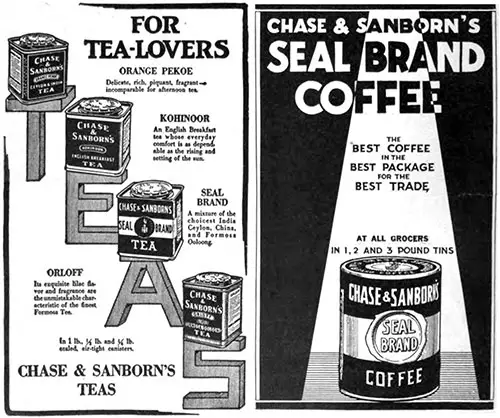
New England Tea and Coffee House Records Signal Expansion in Its 58th Year—Has Always Cooperated with Retailers
A study of the growth of any successful business is not only instructive but stimulating. It is particularly so, perhaps, when that development has been free from the theatrical and along conservative lines over a long period. Such a business is that of Chase & Sanborn, importers of teas and coffees.
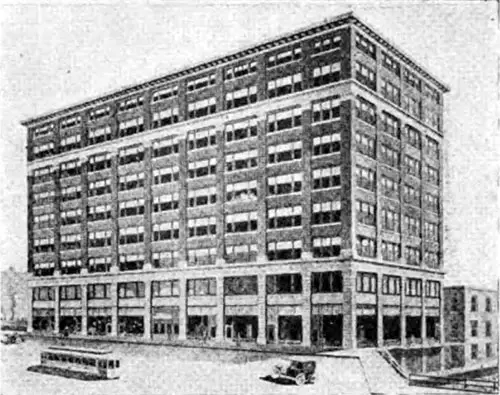
Chase & Sanborn's New Chicago Home
An important forward step in the history of this firm was the recent acquirement of an imposing new home in Chicago. The structure is strategically located at North Wells St. and the Chicago River and claims rare transportation facilities both by rail and water.
It stands on a site fronting 181 feet on North Wells by 82 feet along the river on the south and 82 feet along the Chicago & Northwestern Railway on the north, and contains 14,820 square feet, practically all of which is covered with a nine-story, basement and subbasement, reinforced concrete building.
It has light on all sides, four elevators, and is one of the most substantial ever erected in Chicago. It will be occupied in its entirety to care for the firm's increasing western business.
The Firm’s Founders
Caleb Chase and James S. Sanborn were founders of this one of New England's oldest and business institutions, and its position in the trade today, the character and scope of its activities, may be said to constitute the lengthened shadow of their own sturdy and dominant personalities.
The founding of the business dates back to 1864, with original Boston headquarters at 34 Broad St. These were successively changed to 87 Broad and in 1903 to 200 High St., the present location.
The rapid growth necessitated the establishment of a Chicago branch in 1880, to be followed in 1882 by the opening of a house in Montreal with a view to capturing the cream of Canadian coffee business.
It was early foreseen by these industrial pioneers that the Middle West was destined to become the country's great commercial fighting ground, and there is no nook of the country today in which Chase & Sanborn merchandise may not be found.
Its Fundamental Policies
What have been the underlying policies that explain the upbuilding of a business national in its scope and have made Seal Brand coffee a house hold word in so many homes throughout the land In a curious old advertising booklet issued by the firm in 1882 appears the following:
“It is estimated that there are today some 33,000,000 regular coffee drinkers in the United States and Canada. In these two countries there is now an average yearly consumption of 185,000 tons. This shows a rapid increase, as up to 1861 the average yearly consumption amounted to only about 95,000 tons. But bear in mind that, marching side by side with increased consumption, and keeping pace with it, is an improved public taste imperatively demanding finer drinking coffee.
“Of all the table articles offered for sale by the retailer, we know of none that adds to or detracts from his reputation so much as the quality of his coffee. Believing retailers thoroughly realize this fact, we have striven long and earnestly, making price a secondary consideration, to produce coffee that will perfectly satisfy the consumer.”
Here may be said to be expressed the Chase & Sanborn objective. Of course, there were contributing factors aside from the actual quality of their products, and there seems little reason to doubt that the policy of placing their merchandise with one representative merchant in a town and then protecting him in its sale locally has been of unquestioned benefit.
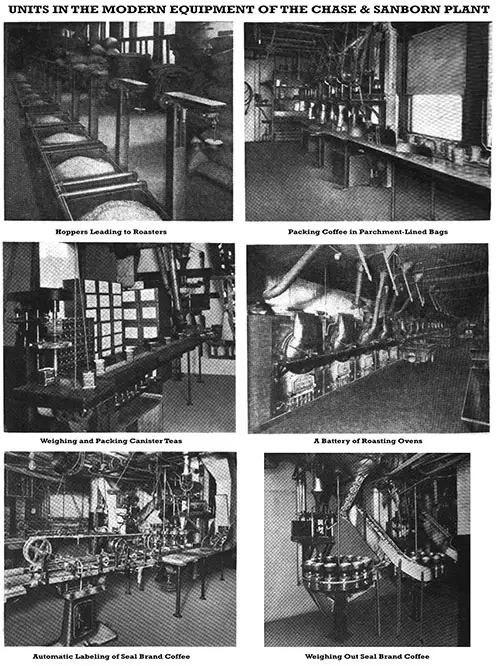
Units in the Modern Equipment of the Chase & Sanborn Plant. Photos: Hoppers Leading to Roasters; Packing Coffee in Parchment-Lined Bags; Weighing and Packing Canister Teas; A Battery of Roasting Ovens; Automatic Labeling of Seal Brand Coffee; and Weighing out Seal Brand Coffee.
While, because of changed conditions, this is not now the factor it once was, yet it is easy to believe that the arrangement must have been found mutually advantageous. Certainly it was one that secured dealer goodwill to an extent that these relationships with the trade, early established and cemented through the years, have proved stanch bulwarks in times of stress and a real cornerstone of present-day success.
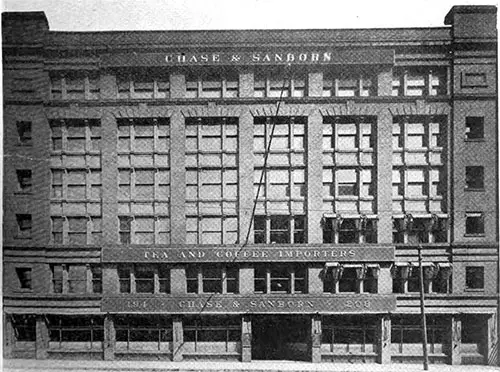
The Chase & Sanborn Headquarters at 200 High St., Boston
Helping the Retailer
Ask any dealer handling Chase & Sanborn's teas and coffees and he will say that he has continuously received practical assistance in moving their merchandise from his shelves. The magazine, the streetcar, and the newspaper have been variously employed in securing consumer publicity.
Unique among dealer helps have been the educational booklets, for country-wide distribution in homes, libraries, and schools. The History of the American Flag, North American Birds, Animal Booklets, Butterfly Booklets, Tea and Coffee Booklets, and more recently the Story of the Pilgrim Fathers have been notable examples of a kind of advertising that has been productive of lasting goodwill, since it not only educated old and young alike in worth-while subjects but, in the case of the children, acquainted them in their most impressionable years with Chase & Sanborn merchandise.
Advertising that effectively introduced their goods to Far Western merchants was the exclusive serving of Seal Brand coffee in cafes and restaurants at the Chicago World's Fair in 1893.
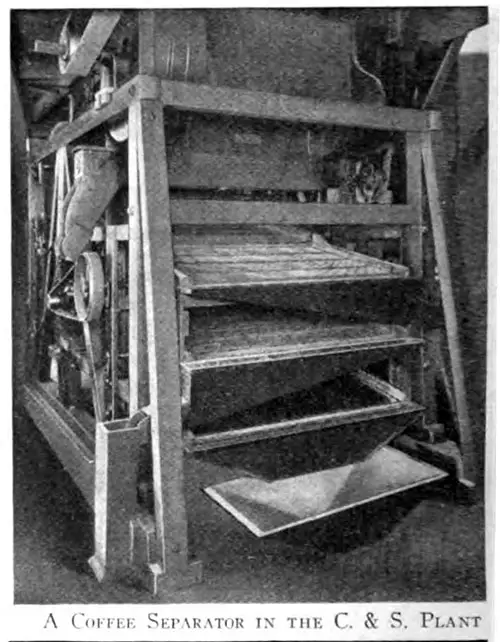
A Coffee Separator in the Chase & Sanborn Plant
In the past years the firm has been responsible for what at the time was marked innovations in methods of merchandising and matters of distribution. In this same advertising booklet printed in 1882 is found the following interesting mention of what in that day was a distinctly forward step in merchandising:
“We have a style of packing roasted coffee which is proving very popular, and we feel deservedly so. It is an air-tight hermetically sealed tin can; each can provided with a screw top, making an opening large enough to. Retail direct from the can.
Coffee packed in this way retains its strength and fragrance for months, and allows it to be shipped any distance, arriving at its destination crisp and fresh. These cans hold 50 and 25 pounds, respectively, and are strongly crated before shipping. Each can is fastened by a seal bearing our signature. In buying our brands see that this seal is not broken or missing.”
Just as Chase & Sanborn were the first ship coffee in 50-pound hermetically sealed cans, so too their Seal Brand claims the distinction of having been the first coffee to appear upon the market packed in one- and two-pound tins.
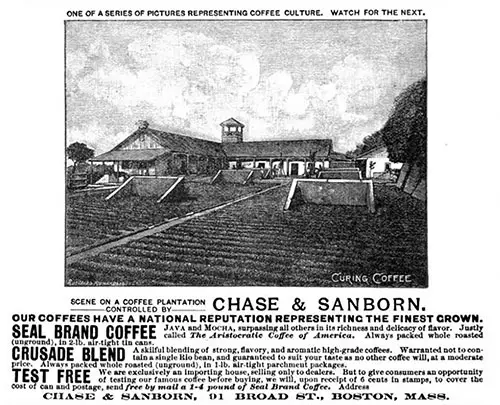
A Chase & Sanborn Advertisement In Harper's And Scribner's Magazines, November 1888
"Growth of Chase & Sanborn," in The Tea and Coffee Trade Journal, New York: The Tea and Coffee Trade Journal Co., Vol. 42, No. 4, April 1922, p. 484-490.
